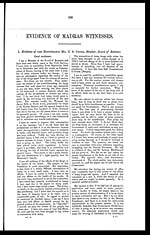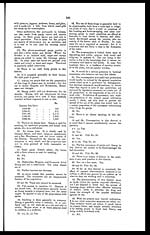Medicine - Drugs > Report of the Indian Hemp Drugs Commission, 1894-1895 > Volume VI > Evidence of Madras witnesses
(182) Page 164
Download files
Individual page:
Thumbnail gallery: Grid view | List view

164
without there being any sufficient justification for
the adoption of that elaborate system.
I think that the prohibition of cultivation, ex-
cept in restricted tracts, would be a hardship in
respect to this, that the wrong people would be
prosecuted. The Salt and Abkari Department
has developed as effective a set of blackguards as
we have in India when they are not controlled;
and it would be an added terror to village life to
let them loose on respectable raiyats. I should
not like to be responsible for this. The opium
question cannot be regarded as throwing light on
this; for there restriction is old and long esta-
blished. It has settled down. We have no-
thing to do with it in this presidency. It is pos-
sible that existing establishments might enforce
prohibition of cultivation, but I do not think they
could without difficulty and abuse.
To drive the people by high taxation from the
drug to alcohol might not be any advantage. I
am doubtful. I know that the revenue has been
recently very largely increased; and I am not sure
that we need do more than leave the auction sys-
tem to act. I think it would be quite fair to say
this is an exciseable article and must not be grown
without a license. This would be fair if feasible.
I did not see my way to it. The limit of increased
taxation as influencing price which I should be
inclined to fix at present would be such as would
not drive the people to alcohol. I see nothing at
present to justify me in thinking that that would
be a desirable change to bring about.
By the improvement effected in 1889, facts
were ascertained which were not known before.
This led to the facts regarding private cultivation
being ascertained. This information cannot be
regarded as general, because in the Madras Presi-
dency the village system enables us to get the
fullest information regarding all the circumstances
of the people. The system differs in this respect
from Bengal. Our village agency puts us in
possession of very clear views of facts if we in-
quire into them. The facts are that the hemp
plant is found strewed in certain localities in the
back-yards of any people who wish to cultivate it.
This is the truth. And all that the Department
knows is in a general way that that is so. I
should like, for purposes of the careful control I
have indicated, to have a return showing actually
what was grown and what was done with the drug.
But that would cost too much. The only other
plan would be to restrict cultivation. If you were
to order the stoppage of cultivation of hemp—or
even rice—it would be done. There would be no
difficulty in having the order carried out. The
people would stop the cultivation: they are quite
amenable. It would be stopped without the neces-
sity of espionage and interference; but there
would always be the risk of false charges. In
Malabar they put toddy into a man's pots and
get up a false charge. So they might have
the plants handy. In Madras you could carry
out any order, but it involves this risk. There
is no agitation in Madras in favour of hemp;
so I believe there would be complete submis-
sion. I understand that political agitators are
entirely on the other side as far as this presi-
dency is concerned. I am not prepared to commit
myself to any opinion on the general question,
whether, if the result of this inquiry elsewhere
proved that the drug was specially injurious, the
best time to inaugurate restrictive measures would
be before the use became extensive, for the ques-
tion is so extremely hypothetical in this presi-
dency. There is, I believe, no tendency here in
the use of this drug to extend, and I believe more
people in this presidency injure themselves from
tea than from hemp.
2. Evidence of MR. J. STURROCK, Collector, Coimbatore.
1. I have no personal knowledge in the matter.
Concise replies gathered from the reports of my
subordinates and the district medical officer,
Coimbatore, are given below.
2. The definitions given may be generally ac-
cepted; but charas does not seem to be used or
generally known.
3. It does not grow spontaneously in this
district.
4. There are local names for the plant from
which ganja is made; but I cannot tell whether
they are all exactly the same plant or not.
5. There is no wild hemp grown in the dis-
trict.
7. The ganja plant is cultivated on a few of
the garden lands and in backyards of a few of
the houses. The cultivation is not extensive,
and it is rare to find more than four or five plants
in the places where they are grown. Ganja,
bhang, and another preparation called majum are
made from the leaves, and no other use is made
of the plant.
8. There has been neither increase nor de-
crease.
9. No particular method is adopted in the cul-
tivation of the cultivated ganja plants, which
grow in the midst of other plants, which require
watering like garden products.
10. The cultivators are the same as the agri-
cultural classes.
11. No.
12. No.
13. Not restricted. It is grown here and there
in the district. It is reported to grow in brackish
soil and in moderately hot climate. The ground
must be kept always moist. It cannot be grown
on dry land. It is grown on garden lands which
contain wells.
14. (a)Ganja is prepared to a small extent
here and three throughout the district.
(b) No.
(c) Bhang is prepared to a small extent.
15. (a) (A) A little water is sprinkled on a
few ganja dry leaves and pressed by the thumb
of the right hand in the hollow of the left palm,
so as to separate the seeds, after which small
pieces of tobacco are added to it, and it is then
placed in a clay pipe called chillumand smoked.
(B) Ganja leaves are ground with jaggery,
spices, etc., and made into confections, of which
the most common is called majum, and is made
as follows:—Dried ganja leaves are soaked in
water for three days, cleared with water twice,
dried in the sun or over a fire and reduced to pow
der. This is mixed with another powder made
up of a number of spices, such as pepper, dry
ginger, cardamom, etc. The composition is put
Set display mode to: Large image | Zoom image | Transcription
Images and transcriptions on this page, including medium image downloads, may be used under the Creative Commons Attribution 4.0 International Licence unless otherwise stated. ![]()
| India Papers > Medicine - Drugs > Report of the Indian Hemp Drugs Commission, 1894-1895 > Volume VI > Evidence of Madras witnesses > (182) Page 164 |
|---|
| Permanent URL | https://digital.nls.uk/74909544 |
|---|




